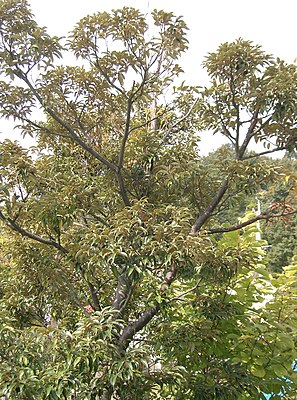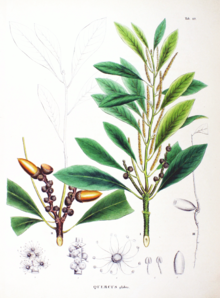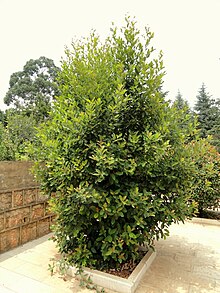Beech family
| Beech family | ||||||||||||
|---|---|---|---|---|---|---|---|---|---|---|---|---|

|
||||||||||||
| Systematics | ||||||||||||
|
||||||||||||
| Scientific name | ||||||||||||
| Fagaceae | ||||||||||||
| Dumort. |
The beech plants (Fagaceae) are a family in the order of the beech-like (Fagales) within the flowering plants (Magnoliopsida). The eight to twelve genera with around 670 to 900 species mostly thrive in the cold to temperate, less often in the subtropical to tropical climates, predominantly in the northern hemisphere .
description



Appearance and leaves
All species of the Fagaceae family are woody plants and usually grow as trees or rarely shrubs . They are evergreen or deciduous.
The alternate and two-line or spiral leaves are divided into a petiole and a leaf blade. The leaf blades are often leathery. The leaf margins are smooth, serrated or serrated. If the leaf margin is smooth, the lateral nerves do not reach the leaf margin. The leaf surfaces are covered by simple, star-shaped or branched hairs ( trichomes ). Stipules are present.
Inflorescences and flowers
The flowers are grouped in upright or pendulous, simple inflorescences , here called kittens. All species are single sexed ( monoecious ), that is, there are female and male flowers on one plant, the flowers of one sex are grouped together in inflorescences. The unisexual flowers are radial symmetry . There are two times three free bracts or the bracts are fused and end with four to six lobes. There are four to twenty stamens in the male flowers . The female flowers contain Staminodien and usually three to six (2 to 15) carpels have become an under constant ovary grown. There are two hanging, anatropic, bitegmic ovules per ovary compartment . The pollen is mostly spread by wind, but in some species, especially of the Castanea genus, by insects.
Fruits and seeds
The fruits typical for this family are nuts , up to three of them sit together individually (depending on the genus) in an axis cup, also called fruit cup or cupula. That is why the family is also known as Cupulaceae . The fruits are spread by animals. The seeds are often intensely surrounded by hairs that originate in the endocarp .
Sets of chromosomes
The basic chromosome numbers are usually x = 12, rarely 11, 13 or 21.




Systematics and distribution
The Fagaceae family was established in 1829 by Barthélemy Charles Joseph Dumortier in Analyze des Familles de Plantes , 11, 12. The type genus is Fagus L. A synonym for Fagaceae Dum. is Quercaceae Martinov.
The family Fagaceae is divided into two subfamilies with a total of eight or ten (previously six to seven) genera and about 670 to 1000 species:
- Subfamily Fagoideae K. Koch : It contains only one genus with about ten species:
- Subfamily Quercoideae Oerst : It contains about seven genera with about 640 species:
- Chestnuts ( Castanea Mill. ): The seven to twelve species are mainly found in the temperate zone of Eurasia.
- Sham chestnuts ( Castanopsis (D.Don) Spach ): The 120 to 200 species are common in tropical and subtropical Asia.
- Chrysolepis Hjelmq. : The only two species are native to the western United States.
- Lithocarpus flower : The approximately 120 to 300 species are almost exclusively distributed in tropical, southeastern Asia (especially Borneo ). The only North American species, Lithocarpus densiflorus (Hook. & Arn.) Rehder in older literature, wassplit offas a separate genus, Notholithocarpus (literally: "false Lithocarpus ").
- Notholithocarpus Manos, Cannon & SHOh :split offfrom Lithocarpus on the basis of molecular genetic studies in 2008. The only species, Notholithocarpus densiflorus (Hook. & Arn.) Manos, Cannon & SHOh , occurs in California and neighboring Oregon.
- Oak ( Quercus L. ): The approximately 400 to 600 species are common in the northern hemisphere.
-
Trigonobalanus Forman (Syn .: Colombobalanus Nixon & Crepet , Formanodendron Nixon & Crepet ): There are three species that are recognized as independent genera, especially by Fagacean researchers:
- Trigonobalanus doichangensis (A.Camus) Forman (Syn .: Formanodendron doichangensis (A.Camus) Nixon & Crepet ): It occurs in China and northern Thailand.
- Trigonobalanus excelsa Lozano (Syn .: Colombobalanus excelsa (Lozano, Hern. Cam. & Henao) Nixon & Crepet ): It occurs only in Colombia.
- Trigonobalanus verticillata Forman : It occurs in Hainan, Malaysia, Borneo, Sumatra and Sulawesi.
In older literature, the false beeches or southern beeches ( Nothofagus Blume ) with around 35 species are classified in this family. In the course of the evaluation of molecular genetic data, the Nothofagus species ( APG I system and the following) were placed in a separate family of beech trees (Nothofagaceae).
use
Many species provide valuable wood .
The seeds of some species are eaten raw or cooked. It is tannin obtained. Oil is obtained from some species. The medicinal effects of individual species were examined.
swell
- Description of the Fagaceae family on the AP website. (Sections Description and Systematics)
- The family of the Fagaceae s. l. at DELTA by L. Watson & MJDallwitz. (Section description)
- Chengjiu Huang, Yongtian Zhang & Bruce Bartholomew: Fagaceae - online with the same text as the printed work , In: Wu Zheng-yi & Peter H. Raven (Eds.): Flora of China , Volume 4 - Cycadaceae through Fagaceae , Science Press and Missouri Botanical Garden Press, Beijing and St. Louis, 1999. ISBN 0-915279-70-3 (Description section)
- Kevin C. Nixon: Fagaceae - the same text online as the printed work , In: Flora of North America Editorial Committee (Ed.): Flora of North America North of Mexico , Volume 3 - Magnoliidae and Hamamelidae , Oxford University Press, New York and Oxford, 1997, ISBN 0-19-511246-6 . (Section description)
Individual evidence
- ^ Fagaceae at Tropicos.org. Missouri Botanical Garden, St. Louis
- ^ A b Paul S. Manos, Zhe ‐ Kun Zhou, Charles H. Cannon: Systematics of Fagaceae: Phylogenetic Tests of Reproductive Trait Evolution . In: International Journal of Plant Sciences . tape 162 , no. 6 , November 2001, ISSN 1058-5893 , p. 1361–1379 , doi : 10.1086 / 322949 ( uchicago.edu [accessed January 24, 2020]).
- ↑ World Checklist and Bibliography of Fagales (Betulaceae, Corylaceae, Fagaceae and Ticodendraceae) . ( uchicago.edu [accessed January 24, 2020]).
- ^ Fagaceae in the Germplasm Resources Information Network (GRIN), USDA , ARS , National Genetic Resources Program. National Germplasm Resources Laboratory, Beltsville, Maryland.
- ^ Charles H. Cannon, Paul S. Manos: Phylogeography of the Southeast Asian stone oaks (Lithocarpus) . In: Journal of Biogeography . tape 30 , no. 2 , February 2003, p. 211–226 , doi : 10.1046 / j.1365-2699.2003.00829.x ( wiley.com [accessed January 24, 2020]).
- ↑ Paul S. Manos, Charles H. Cannon, Sang-Hun Oh: Phylogenetic Relationships and Taxonomic Status Of the Paleoendemic Fagaceae Of Western North America: Recognition Of A New Genus, Notholithocarpus . In: Madroño . tape 55 , no. 3 , July 2008, ISSN 0024-9637 , p. 181–190 , doi : 10.3120 / 0024-9637-55.3.181 ( bioone.org [accessed January 24, 2020]).
- ↑ a b c Rafaël Govaerts (Ed.): Trigonobalanus. In: World Checklist of Selected Plant Families (WCSP) - The Board of Trustees of the Royal Botanic Gardens, Kew . Retrieved April 13, 2020.
- ↑ Entries on Fagaceae in Plants For A Future
Web links
- Fagaceae Genomics website . (English)
